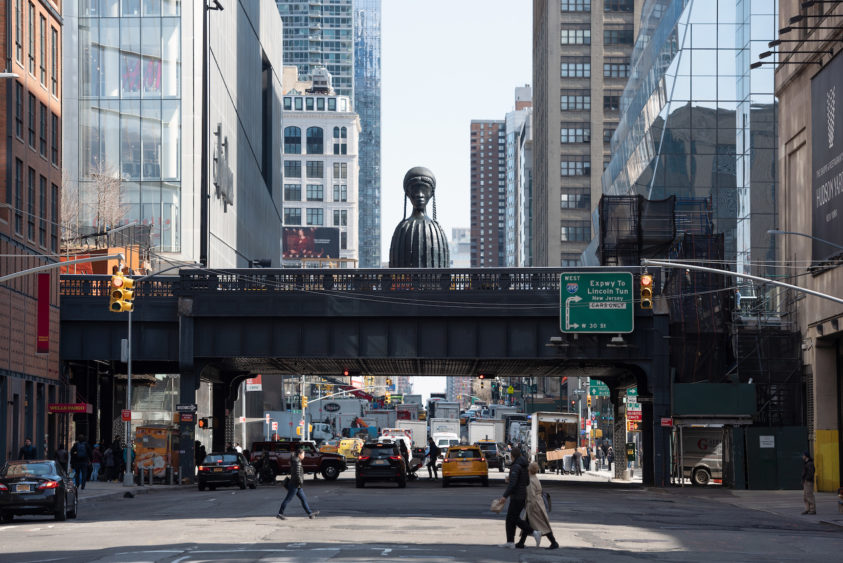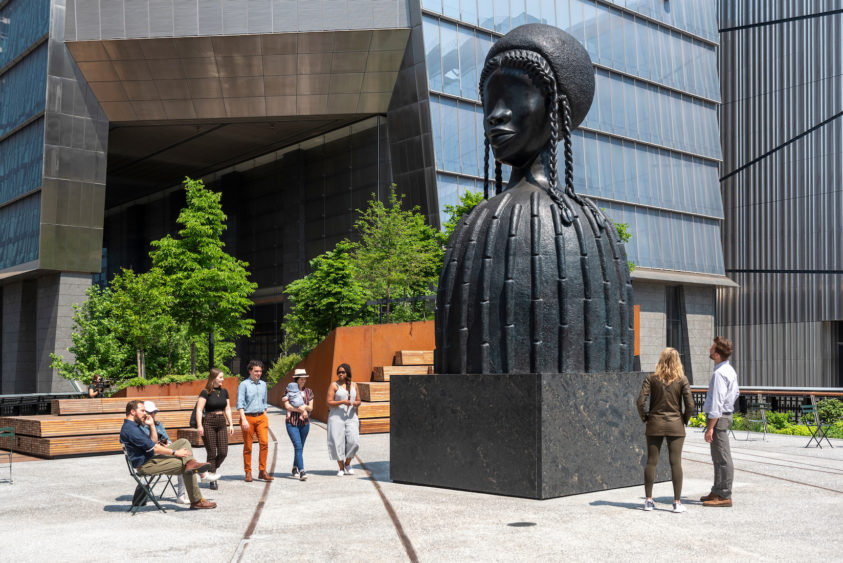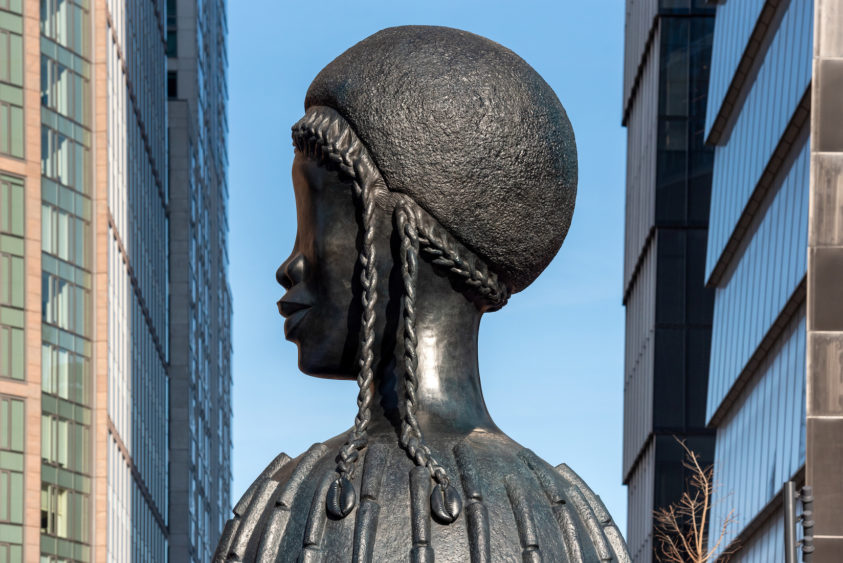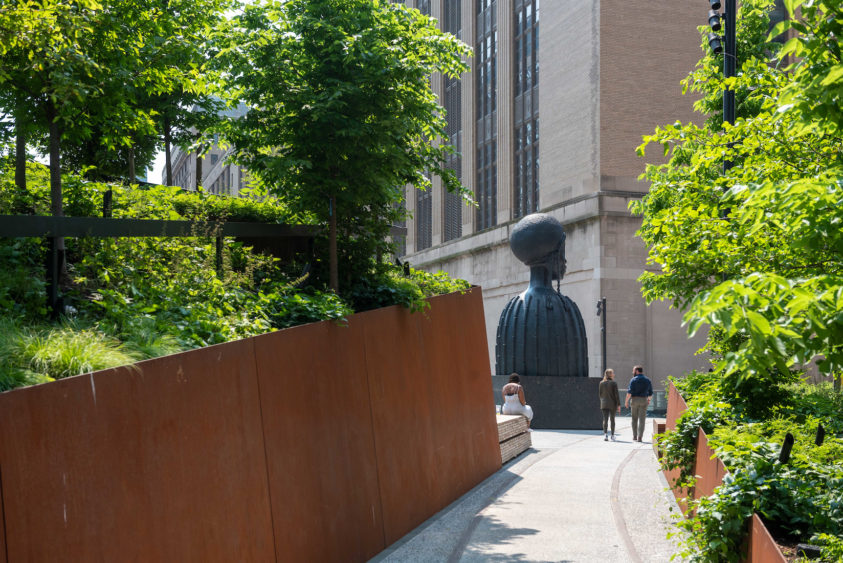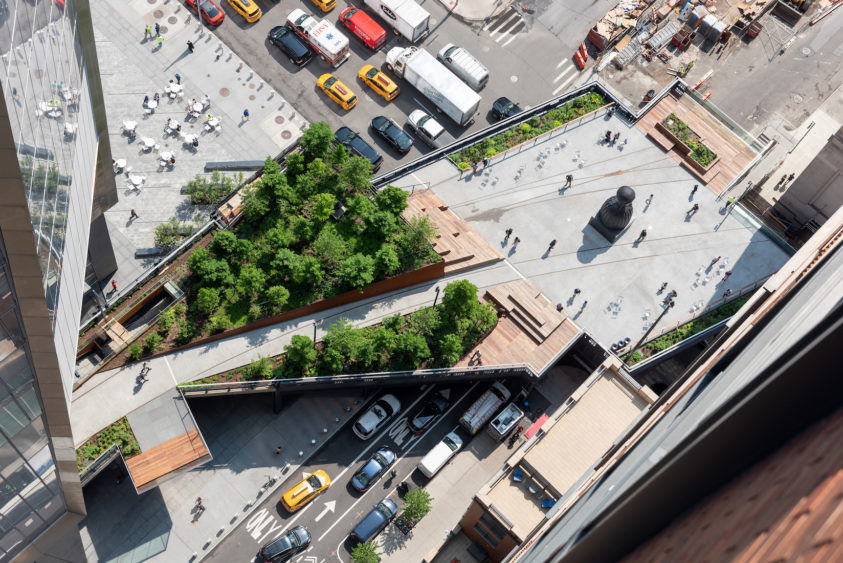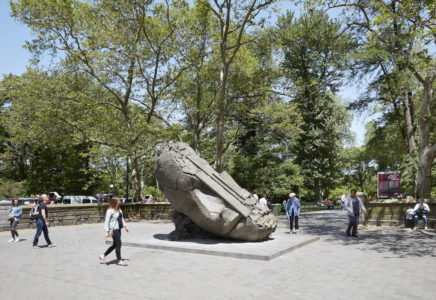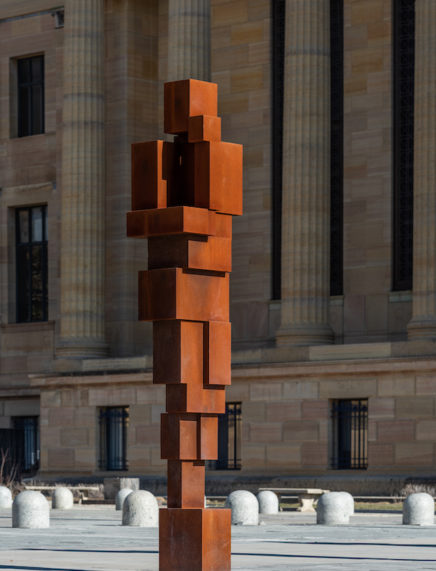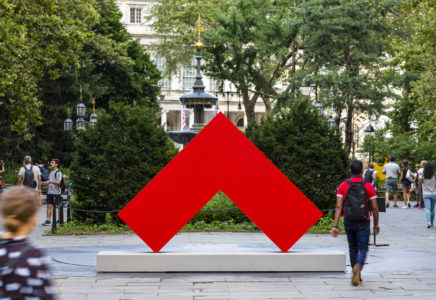Simone Leigh on the High Line
Simone Leigh’s monumental female bust, entitled Brick House, is the inaugural sculpture on the High Line’s Plinth, a space located on 30th Street and Tenth Avenue. The Plinth, opened quite recently, is dedicated to public sculpture, of which Brick House is the first to be exhibited in the program. Some 16 feet high, this bust of a black woman with an even demeanor looks out over Tenth Avenue, asserting a racial presence in sculpturally figurative terms. According to press notes, the influences behind Brick House are varied and complex–usually combining references to African and African-American architecture with the human body. In the case of Brick House, the influences, most specifically regarding the rounded forms of the figure’s lower half, include Battammaliba architecture from Benin and Togo; the teleuk of the Mousgoum people of Cameroon and Chad; and the construction forms of Mammy’s Cupboard in the American South. Eyeless, with a flattened face, the head addresses viewers with a complex treatment of her hair. A short afro covers most of the sculpture’s head, with four braids descending from a braid circling the bottom of the close haircut. The braids are completed by cowrie shells that drape across the shoulders of the woman’s body.
Influences aside, the presence of the female figure is unusually powerful. The social circumstances of the work reflect an increased interest in the arts of African people among artists of the African diaspora, American or in the case of Leigh, Jamaican-American. By including references to other cultures, Leigh is establishing a pan-African base for this work, which eschews a Western presence for one deeply joined to the arts of Africa. The alternative presence of such references makes it clear that, especially in America, where diasporas from many parts of the world occur, a new orientation toward the past is taking place. It is one in which non-white peoples draw from their own history, even as they create work that pulls together previous modernist creativities originating in the West one hundred years ago. This is a time of determined eclecticism, which can be exciting but which can also result in a surface treatment of the appropriation, so that the cultural influence is diminished by an extreme lack of depth. In America, the diasporas now tend to merge–pan-Asian culture is coming about, as is pan-African. In exchange for a greater openness to generalities of achievement, we also lose the particularities of the cultures we are borrowing from. So it is dangerous to borrow too widely and too freely–or at least it seems that way, given that we may only be tracing the surface of the culture we are using.
Interestingly, though, this argument cannot apply to Brick House, which wears its cultural accouterments extremely well. The figure is a marvelous African presence on the west side of New York City’s midtown. New York is ever more inclusive of peoples from all over the world, and the city’s cultural institutions are doing a better job of providing opportunities for minorities to present their version of culture, often (but not always) with the inclusion of the cultures they came from. The complexity of impact is almost too great to measure, but in the case of Simone Leigh’s sculpture, we can see how inferences to African architecture are seamlessly brought into use, in ways that complete the work of art without burdening it with too much baggage. How does one play out the astonishingly large number of possibilities in contemporary art, with its preference for jumping, culturally, all over the world? It can be argued, and with justification, that the use of visuals from far away and long ago can overly complicate the esthetic presence of the object at hand–to the point where we hardly know what we are looking at. This is a genuine danger. But it is also true that fine art has a history of interwoven imageries that goes back hundreds if not thousands of years. In Leigh’s case, though, these problems do not occur. Instead, she has constructed a persona that is informed by different national cultures of Africa, in which the information she works with is handled with both ease and skill. One can hardly underestimate the impact of Brick House, rising monumentally into New York’s gas fumes as it gazes steadily over an anonymous Tenth Avenue, just north of the Chelsea art district but just south of Midtown West. Its existence establishes a presence that speaks to the future of the artworld, concerned as we are to turn our democratic predilections toward artists of all backgrounds.
Maybe, too, it can be said that Leigh is performing a rite of cultural independence in the face of centuries of prejudicial neglect. The figure, supported by a pedestal some three or four feet high, stands in splendid isolation against the tall buildings that surround it. Still, determinedly, she retains her identity, in ways that not only redeem the precedent culture supports informing the figure, but also in a fashion enabling the black arts community in New York to look ahead–to a place where the promise of black culture is fully understood and acts as an encouragement for more work of such a nature. Leigh is a fairly recent addition to a group of African-American artists whose work stays well within the boundaries of black culture–look at the narrative paintings of Kerry James Marshall, or the racialized silhouettes of Kara Walker. There is now a strong tradition, beginning with the art of Jacob Lawrence and Romare Bearden, of art that trades on the inherent strengths of both Western and African legacies, which is devoted to adumbrating the details and nuances of contemporary black culture. One way of doing this is to find strengths and alignments from earlier African histories and cultural developments, so that the image at present possesses the aura deriving from a particular past. Brick House has that aura, and it may well need it, given the rough construction of the streets beneath it, as well as the inevitable cultural distance of a city dedicated to making money. That statement, though, is speculation, and we can be glad to say that Brick House is an outstanding first example of what we can hope is a series of efforts dedicated to enlarging the cultural implications of public sculpture in New York–from modernist formalism to a more culturally specific imagery, one embracing legacies other than the ones we know by heart. The kind of specificity informing Leigh’s work is a leap ahead to an art that finds its support in past attributes not well known to current American culture. Thus, Brick House informs and edifies, in ways we may not have experienced before. This is what good art does.
Simone Leigh, Brick House
June 2019 – September 2020
On the High Line at the Spur, at 30th St. and 10th Ave.
